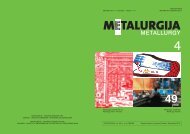Synthesis and potential biological activity of some novel 3-[(N ...
Synthesis and potential biological activity of some novel 3-[(N ...
Synthesis and potential biological activity of some novel 3-[(N ...
Create successful ePaper yourself
Turn your PDF publications into a flip-book with our unique Google optimized e-Paper software.
A. H. M<strong>and</strong>our et al.: <strong>Synthesis</strong> <strong>and</strong> <strong>potential</strong> <strong>biological</strong> <strong>activity</strong> <strong>of</strong> <strong>some</strong> <strong>novel</strong> 3-[(N-substituted indol-3-yl)methyleneamino]-6-amino-4aryl-pyrano(2,3-c)pyrazole-5-carbonitriles<br />
<strong>and</strong> 3,6-diamino-4-(N-substituted indol-3-yl)pyrano(2,3-c)pyrazole-5-carbonitriles, Acta Pharm.<br />
62 (2012) 15–30.<br />
flufenamic acid (53 %) at a dose <strong>of</strong> 20 mg kg –1 <strong>and</strong> indomethacin (51 %) at a dose <strong>of</strong> 5 mg<br />
kg –1 . The presence <strong>of</strong> aminopyrazole at position 3 <strong>of</strong> indole as in compounds 6b <strong>and</strong> 6g<br />
showed inhibition (50 %) dose to that <strong>of</strong> flufenamic acid (53 %) <strong>and</strong> indomethacin (51<br />
%). Only, compounds 6a, 6e, 4e <strong>and</strong> 4g exhibited inhibition effects <strong>of</strong> 39, 39, 33 <strong>and</strong> 32 %<br />
at a dose <strong>of</strong> 5 mg kg –1 compared to indomethacin (51 %) at a dose <strong>of</strong> 5 mg kg –1 .<br />
Analgesic <strong>activity</strong> <strong>of</strong> the synthesized compounds was studied using a p-benzoquinone<br />
induced writhing response in mice. The obtained data (Table IV) indicated that compounds<br />
2e, 3d, 4g, 6g, 7d <strong>and</strong> 7g, at a dose <strong>of</strong> 20 mg kg –1 , showed the same equipotent<br />
writhing inhibition <strong>of</strong> 66 % as indomethacin at a dose <strong>of</strong> 5 mg kg –1 . On the other h<strong>and</strong>,<br />
the most active test compounds were in the descending order <strong>of</strong> 2e, 3d, 4g, 6g, 7d, 7g ><br />
2d, 3b, 3g, 4f > 3e, 4e, 6d, 6e, 7e with writhing inhibition <strong>of</strong> 66, 50 <strong>and</strong> 42 % compared to<br />
flufenamic acid (83 %) at a dose <strong>of</strong> 20 mg kg –1 . From the data obtained writhing inhibitions<br />
<strong>of</strong> the newly synthesized compounds seem to relate with the presence <strong>of</strong> halo atoms<br />
in these compounds.<br />
Anticonvulsant properties <strong>of</strong> the tested compounds were studied using the electric<br />
shock seizure test. Data obtained (Table V) revealed that compounds 2d, 2e, 3d, 4c, 4f, 4g,<br />
6a <strong>and</strong> 6d, at a dose level <strong>of</strong> 25 mg kg –1 , showed anticonvulsant protection (50 %) as did<br />
the reference drug diazepam at 5 mg kg –1 , while compounds 3b, 3e, 4d, 6e, 7d <strong>and</strong> 7e, at<br />
26<br />
Compd.<br />
No.<br />
Table V. Anticonvulsant <strong>activity</strong> <strong>of</strong> the most anti-inflammatory active compounds<br />
Dose<br />
(mg kg –1 )<br />
Inhibition<br />
(%)<br />
Compd.<br />
No.<br />
Dose<br />
(mg kg –1 )<br />
Inhibition<br />
(%)<br />
2d 25 50 4g 25 50<br />
12.5 16 12.5 16<br />
2e 25 50 6a 25 50<br />
12.5 33 12.5 33<br />
3b 25 66 6d 25 50<br />
12.5 33 12.5 16<br />
3d 25 50 6e 25 66<br />
12.5 33 12.5 33<br />
3e 25 66 6g 25 33<br />
12.5 33 12.5 16<br />
3g 25 33 7d 25 66<br />
12.5 16 12.5 16<br />
4c 25 50 7e 25 66<br />
12.5 16 12.5 16<br />
4d 25 83 7g 25 33<br />
12.5 50 12.5 16<br />
4e 25 100<br />
Negative controla 12.5 66<br />
0 0<br />
4f 25 50 Diazepama 5 50<br />
12.5 16<br />
a 2 % Tween 80 is a negative control, also solvent for tested compounds <strong>and</strong> diazepam.

















